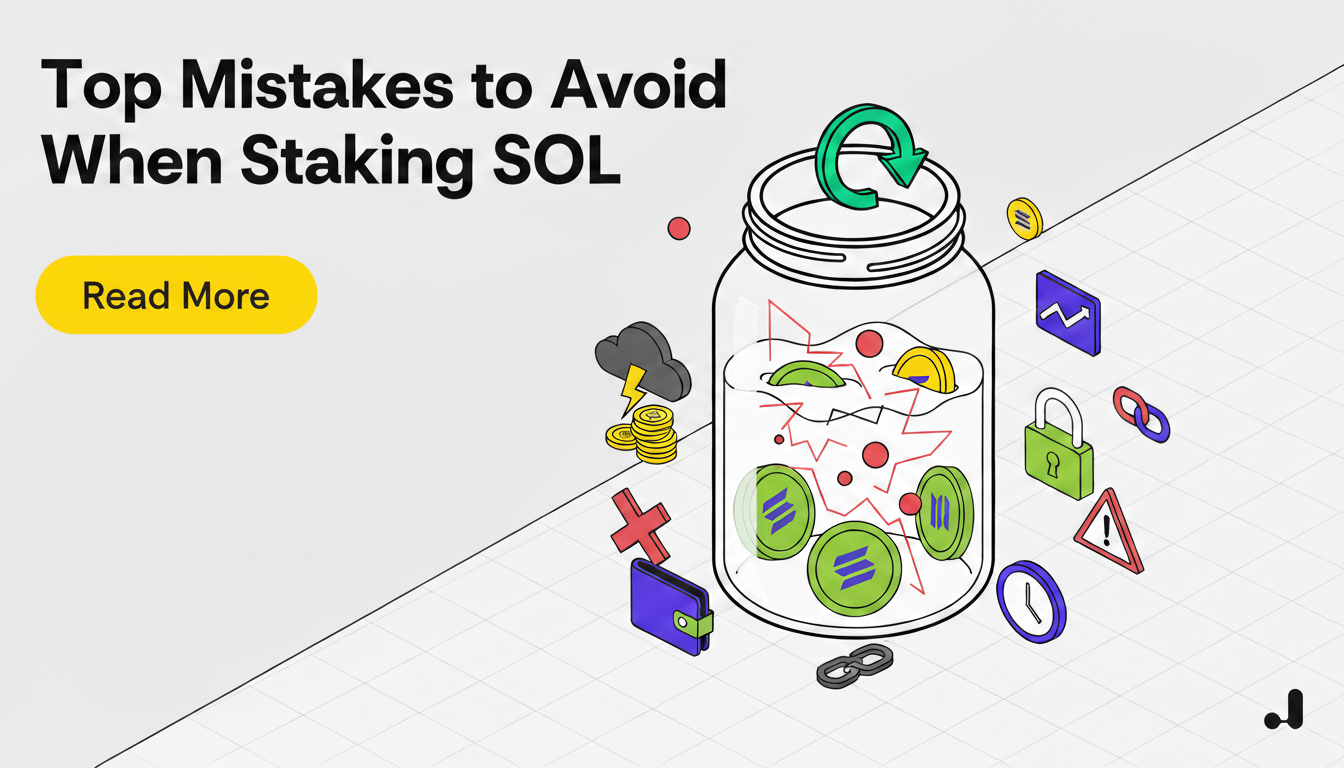Staking SOL looks simple from the outside: delegate tokens, earn rewards, and help secure the network. But in practice, beginners repeat the same staking mistakes that reduce earnings, trap funds, or expose them to unnecessary risk. Most of these errors are avoidable once you understand how staking actually behaves on-chain, what affects rewards, and where the hidden pitfalls are.
This guide breaks down the common staking mistakes Solana ****users make, why they happen, and what to do differently if you want to earn consistently without blocking yourself from opportunities.
Mistake 1 — Staking Without Understanding the Lock-Up
A lot of first-time delegators press “delegate” and only later discover that their SOL are locked and cannot be moved immediately. Native staking requires an unstaking period before your tokens are liquid again. If you need capital during that time, you simply can’t access it. This one misunderstanding is the reason many people get stuck during market moves.
How to avoid staking losses from this:
Before staking, decide whether you will need liquidity. If you may want flexibility, consider liquid staking solutions that allow you to exit or rotate positions without waiting through the unlock period.
Mistake 2 — Picking a Validator Blindly
Many users choose a validator by name, by random selection, or by the highest APY. This approach ignores reliability, commission, and history. Validators with poor uptime or bad configuration reduce your rewards and sometimes even slash your earnings indirectly.
Safe staking practices Solana users should follow:
Research validator track record, commission rates, and uptime before delegating. Spread stake across reliable validators rather than placing everything into an unknown node.
Mistake 3 — Ignoring the Value of Liquidity Entirely
Some users treat staking like a bank deposit and forget that crypto is a dynamic environment. Markets move, new DeFi opportunities launch, and capital sometimes needs to be reallocated. Locking all SOL with no liquid layer leaves you unable to react.
How to choose staking strategy wisely:
If you are an inactive holder, locking may be fine. If you are an active user, leave at least a portion liquid or use solutions that maintain liquidity underneath.
Mistake 4 — Staking on Impulse After Reading a Guide Once
People often search “how to stake SOL for rewards,” find a two-step wallet tutorial, and execute immediately. They never examine validator decentralization, yield structure, unstake timelines, or liquidity alternatives. That shortcut mindset causes slow losses and missed upside.
Staking security tips Solana users overlook:
Don’t delegate before you understand what you are committing to. Read beyond the button, not just the interface instructions.
Mistake 5 — Treating Staking as Risk-Free
Many assume staking SOL is guaranteed income with no downside. That belief hides multiple categories of exposure: validator failures, price divergence when using derivative tokens, and market-timing risk during unlock periods.
Beginner staking errors to avoid:
Recognize that staking is not a shield against volatility. A staking position can lose value if price moves against you while you remain locked.
Mistake 7 — Not Diversifying Across Staking Paths
Some users put 100% of SOL into one validator or a single staking mechanism. This concentrates exposure unnecessarily.
Practical correction:
Split between direct staking and liquid staking if you are unsure. This reduces operational and timing risk while allowing you to compare both approaches in real conditions.
Mistake 8 — Delegating and Then Never Monitoring Again
Staking is not “set and vanish forever.” Validators can degrade, DeFi integrations can change, and rewards can drift. Leaving a position unmonitored for months is how people discover slow performance leaks far too late.
Safe staking practices Solana holders should follow:
Check validator performance periodically or, if you’re using liquid staking through JPool platform, use its built-in validator dashboard to monitor delegation health and track token behavior on DEXs.
Mistake 9 — Unstaking Reactively Instead of Deliberately
Unstaking on Solana isn’t instant. Deactivation completes only at epoch boundaries (roughly every ~2 days) and sometimes can take multiple epochs. If you wait until you urgently need funds, that delay can leave you unable to redeploy capital when you want.
Better policy:
Split stake accounts so you can deactivate only what you need. Keep some liquidity — either as unstaked SOL or via a stake-pool/liquid-staking token ****— while recognizing the trade-offs (derivatives can diverge from SOL’s price and introduce additional program risk).
Mistake 10 — Assuming All Liquid Staking Is the Same
Not all liquidity solutions behave alike. They differ in validator strategy, integration depth, exit mechanics, and economic design. Treating them as interchangeable is another silent leak in returns.
How to avoid staking losses caused by wrong assumptions:
Evaluate how a liquid staking token is integrated in the Solana ecosystem before committing to it. The utility of the derivative is part of the real yield.
What All These Errors Have in Common
Almost every mistake in this list comes from treating staking as a button instead of a system. The gap between theory and real results is created by timing, liquidity, validator selection, and user behavior — not just reward rate.
People lose more from structure decisions than from APY differences.
Platform to choose
Some users prefer direct delegation, some choose liquid staking, and many use a hybrid. Platforms such as JPool exist in that middle space — offering both direct and liquid approaches in one place for those who want flexibility without leaving the Solana environment. Mentioning it here is not a recommendation but a practical illustration that different mechanisms exist under one roof for different risk profiles.
Final Takeaway
The biggest staking mistakes are not technical — they are behavioral: locking without thinking, chasing numbers, ignoring liquidity, picking validators blindly, assuming safety, and treating staking as if it needs no oversight. Correcting those mistakes has more effect on long-term outcomes than increasing APY by a single percent.
If you avoid the mistakes above, you will already outperform the average Solana delegator — not by luck, but by structure and awareness.

Leave a Reply